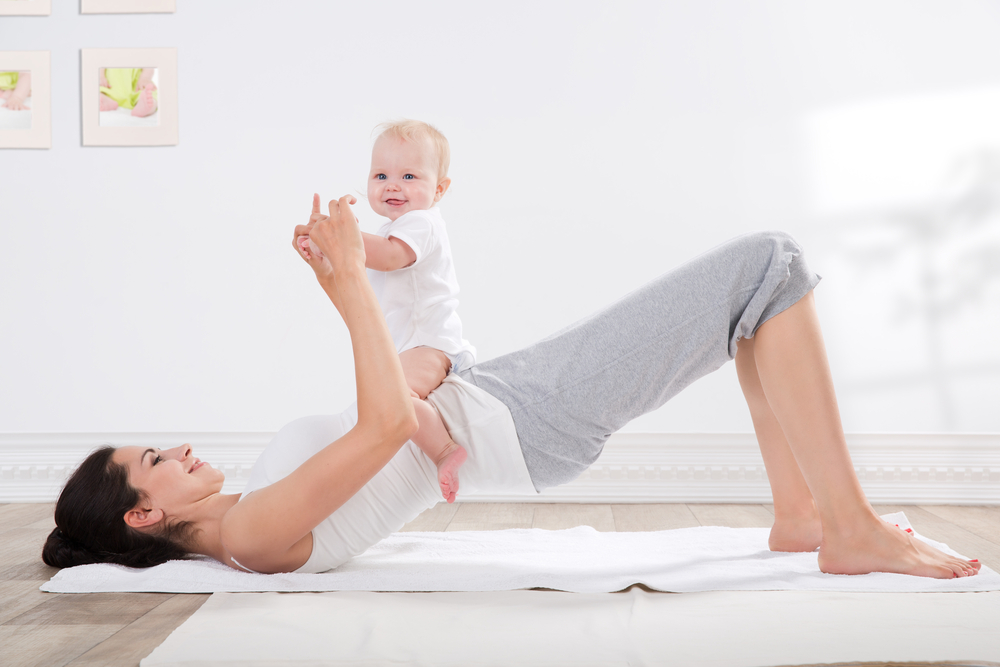- Following pregnancy, women may develop a “pooch,” caused by stretched abdominal muscles and sagging skin.
- Manufacturers claim that postpartum girdles can help reduce post-pregnancy sag, alleviate back pain, and even fix diastasis recti.
- While these garments may hide excess tissue and boost self-confidence, surgeons question their purported medical benefits.
If you’ve ever been asked if you’re expecting — after delivery — you know how frustrating a post-pregnancy potbelly can be.
Medical experts agree that maintaining good abdominal muscle tone through exercise may help prevent the development of a pooch. But what are your options after the damage is done? Can postpartum girdles and wraps actually help you get back into shape? According to the surgeons we spoke with, the answer to your concerns lies elsewhere.
What causes the postpartum pooch?
There are two things that contribute to this problem. First is excess, stretched skin, which won’t simply disappear after the baby is born. Second is diastasis recti — stretching of the two rectus abdominis muscles we’ve come to call a “six-pack,” resulting in a gap, or abdominal separation, between the muscles on either side of the front wall of the abdomen.
As your baby grows, the tissue connecting the two muscles stretches; in fact, under the influence of pregnancy hormones, it becomes more pliable and more slack. Following pregnancy, that tissue can no longer support the torso and abdominal organs, so it tends to sag, leading to the appearance of the pooch.
Roughly 30% of women develop a potbelly after giving birth. The likelihood is increased in the case of multiple pregnancies, carrying two or more babies during one pregnancy, and poor abdominal muscle tone.
“Diastasis recti is a separation of the two vertical rectus abdominis muscles in the center of the abdomen,” New Jersey plastic surgeon Dr. Reza Momeni explains. “Although women can build their core strength, I do not believe they can reunite the two muscles through exercise once they’ve been separated by the stretching forces of pregnancy.”
What are postpartum girdles?
Postpartum girdles are a kind of shapewear. They’re tight abdominal wraps made of breathable, medical-grade fabric, meant to contour the belly, hips, and buttocks while you try to lose weight and tone stomach muscles. Made of nylon and spandex, they’re usually fastened with Velcro.
In the past, European, African, Asian, and South American women commonly wore corsets or similar wraps during the postpartum period to help reduce the size of the uterus and abdominal wall. Recently, celebrities like Gwyneth Paltrow and Jessica Alba have helped to re-popularize similar body shaping wraps.
The purported benefits of the postpartum girdle include:
- Tightening postpartum abdominal muscles, preventing them from sagging
- Restoring curves post-delivery, especially after a C-section
- Providing a simple and discreet alternative to plastic surgery
According to some gynecologists, girdles help push the stretched and sagging rectus abdominis muscles together more quickly, helping women regain their body shape faster.
There are a few rules to follow when wearing postpartum girdles or waist trainers:
- They’re not to be worn during pregnancy.
- They should be worn over an undershirt, to avoid direct contact with skin.
- They’re not to be worn while asleep.
- They should be loosened, adjusted, and tightened at regular intervals to avoid discomfort.
- They are not to be worn continuously.
Do postpartum girdles and belts actually work?
Although they’ve been used for hundreds if not thousands of years, there’s not enough scientific evidence to show that they actually help reduce the post-partum pooch.
“Wearing a girdle won’t do anything for fat or loose skin,” Dr. Momeni says. “Although it might help externally support the loosened abdominal muscles, just like wearing a knee brace or wrist brace for a weak joint, to my knowledge there are no good studies that demonstrate this.”
Some healthcare providers warn that girdles can slacken the muscles of the back, increase the risk of blood clots, lower blood pressure, and lead to stress incontinence (as they firmly bind the abdominal wall).
Moreover, constantly wearing a corset can squeeze your ribs so much that breathing becomes difficult. It may also impede abdominal organs and cause constipation. It’s important to note that girdles do not strengthen or tone abdominal muscles; they only temporarily compress and redistribute skin and fat around the abdominal wall.
“Wearing a postpartum girdle may help hide excess fat and skin, but it won’t address the underlying issues,” Beverly Hills plastic surgeon Dr. Frederic Corbin confirms. “Surgery is the only truly effective option for diastesis recti and skin laxity.”
How can plastic surgery help?
An abdominoplasty, or tummy tuck, is a surgical procedure specifically designed to remove excess skin and tighten sagging abdominal muscles. There are actually a few available variations in the surgical procedure, depending on the severity of diastasis recti and extent of loose skin and fat.
A mini tummy tuck is designed for women whose stretched abdominal wall is confined to below the belly button. It’s performed through a limited incision just above the pubic hairline. In contrast, a traditional abdominoplasty is performed through an extended incision, often from hip to hip, just above the pubic bone. As it is relatively extensive, this procedure is associated with longer recovery times and more postoperative discomfort.
After pulling back the skin, excess fat is removed, and the stretched abdominal wall covering the rectus abdominis muscles is tightened. Next, excess skin is removed and the belly button, which stays attached to the abdominal wall, gets repositioned. This leads to a tighter, flatter tummy. Most women can return to normal activities approximately three months after surgery.
Dr. Joseph Cruise, a plastic surgeon in Orange County, CA recommends the mini tummy tuck for women who want to wear bikinis and low cut pants without showing visible scars.
“Tummy tuck procedures will effectively remove unwanted excess abdominal skin, tighten the muscles, as well as significantly improve any remaining stretch marks,” Cruise says. “The right type of tummy tuck for your body can dramatically alter your shape and silhouette.”
Can any woman get a tummy tuck?
Ideally, the procedure should be performed only if diet, exercise, and a healthy lifestyle have not helped to reduce a new mother’s potbelly. In addition, she shouldn’t be planning to get pregnant again.
Women who undergo tummy tucks are advised to avoid lifting heavy objects for a few months after surgery in order to help tissues heal. Since mothers will generally be lifting their babies more often in the first six months after delivery, it’s better to delay surgery until newborns are a little older.
New mothers are also advised to avoid surgery until after they have stopped breastfeeding — antibiotics and anesthesia received during the surgical procedure can be transferred through breast milk to the baby. As such, the best time to schedule an abdominoplasty is at least 6–9 months after delivery. This timeline is important as it takes approximately that long after birth for tissues and muscles in the abdominal wall to recover.
Is an abdominoplasty risky?
Like any other surgical procedure, complications from anesthesia, bleeding, or infection may accompany a tummy tuck.
Other possible risks include a wound that’s slow to heal, excessive scarring along the incision, a change in skin sensation (especially in the abdominal area and upper thighs), and necrosis of fatty tissue. Complications are more likely in smokers and patients with a BMI of 30 or higher.
The bottom line
Wearing a postpartum girdle may allow you to appear more fit and toned, but unfortunately it offers no permanent benefits.
Abdominoplasty, on the other hand, restores the actual contour to the abdominal wall while removing excess skin and stubborn belly fat.
With or without a girdle or tummy tuck, it’s important to remember that exercise in conjunction with healthy diet and lifestyle are essential for successfully regaining and maintaining healthy, well-toned abdominal muscles and tissue.
» For more information on abdominoplasty, meet our medical review team to get online consultations.









